View in other NatureServe Network Field Guides
NatureServe
Montana
Utah
Wyoming
Idaho
Wisconsin
British Columbia
South Carolina
Yukon
California
New York
- Home - Other Field Guides
- Kingdom - Animals - Animalia
- Phylum - Spiders, Insects, and Crustaceans - Arthropoda
- Class - Insects - Insecta
- Order - Sawflies / Wasps / Bees / Ants - Hymenoptera
- Family - Bumble, Honey, Carpenter, Stingless, & Orchid Bees - Apidae
- Species - Gypsy Cuckoo Bumble Bee - Bombus bohemicus
Gypsy Cuckoo Bumble Bee - Bombus bohemicus
General Description
For definitions and diagrams of bumble bee morphology please see the
Montana State Entomology Collection's Bumble Bee Morphology page. [Remarks pertain to the North America form
B. bohemicus ashtoni, recently reduced to subspecies status of the Eurasian form] A medium-sized bumble bee: queens (no workers) 17-19 mm in length. Hair medium length; hind leg tibia with outer surface convex and densely hairy, lacking pollen basket. Hair on face and upper side of head (occiput) black (sometimes with yellow hairs towards back of head); sides of thorax predominantly black; T3-T4 yellowish to white at sides but T4 usually white at least in middle of back. Male 11-17 mm in length; eyes similar in size and shape to eyes of any female
Bombus; antennae of medium length, flagellum 3X length of the scape; sides of thorax extensively black; T2 entirely black, T4 yellow without extensive black, T7 black (Colla et al. 2011, Williams et al. 2014).
Phenology
[Remarks pertain to the North America form B. bohemicus ashtoni] Across range, queens reported April to September, males June to October (Colla et al. 2011, Williams et al. 2014). In southern Ontario, queens reported April to August, males June to October; earliest record 21 April (Colla and Dumesh 2010).
Diagnostic Characteristics
Please see the
Montana State Entomology Collection's Key to Female Bumble Bees in Montana. [Remarks pertain to the North America form
B. bohemicus ashtoni] Queens differ from other Montana
Bombus by a combination of the outer surface of the hind leg tibia convex and hairy, pollen basket absent; occiput and face predominantly with black hairs, black hairs around base of antennae; hairs on side of thorax predominantly black; T4 yellowish white to white (at least medially); large obvious ridges on edge of S6, but barely extending laterally beyond T6.
Range Comments
[Remarks pertain to the North America form B. bohemicus ashtoni, recently reduced to subspecies status of the Eurasian form] Northeastern US and adjacent southeastern Canada, west in southern Canada to the Rocky Mountains and north into Alaska (Williams et al. 2014). Appears to be undergoing significant declines throughout eastern NA, likely related to parallel declines of primary Bombus host species (Colla and Packer 2008, Colla et al. 2012).
Observations in Montana Natural Heritage Program Database
Number of Observations: 2
(Click on the following maps and charts to see full sized version)
Map Help and Descriptions
Relative Density
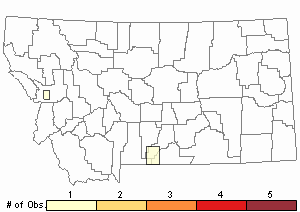
Recency
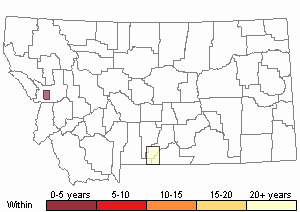
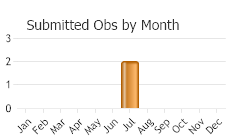
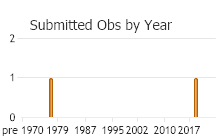
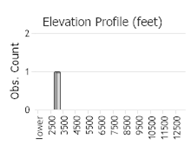 (Observations spanning multiple months or years are excluded from time charts)
(Observations spanning multiple months or years are excluded from time charts)
Habitat
[Remarks pertain to the North America form B. bohemicus ashtoni] Found close to wooded areas, higher elevation woodlands in northeastern mountains, boreal woodlands (Colla and Dumesh 2010, Williams et al. 2014).
Food Habits
[Remarks pertain to the North America form B. bohemicus ashtoni] Does not gather pollen. Reported feeding at a number of plants, including Allium, Aralia, Cirsium, Eupatorium, Hieracium, Melilotus, Penstemon, Rhododendron, Rubus, Rudbeckia, Solidago, Symphyotrichum, Symphytum, Taraxacum, Trifolium and Vaccinium (Plath 1934, Colla and Dumesh 2010, Colla et al. 2011, Williams et al. 2014).
Reproductive Characteristics
[Remarks pertain to the North America form B. bohemicus ashtoni] A social parasite. Does not build its own nest but queen invades and claims host nests of other Bombus species, getting the host workers to raise her young. Thus, does not produce a worker caste. The primary host in the northeast is B. affinis, but also parasitizes B. terricola, and is suspected of parasitizing B. occidentalis and B. cryptarum (Plath 1934, Williams et al. 2014). In the Boston area, parasitized 30.6% of 36 B. affinis colonies, but only 14.3% of 14 B. terricola colonies (Plath 1934). Host nests found by odor recognition. Invading queen B. bohemicus ashtoni do not kill host queens (as other cuckoo bumble bees do), but instead prevent new host queens and males from developing by eating the host queen's eggs and ejecting their larvae. This strategy employed because the invading parasitic queen cannot suppress ovarian development in queen-less host workers, but may "maul" host workers into submission, reducing the likelihood of successful egg production. Parasite queens guard their eggs to prevent them from being discovered and eaten by host workers, but as host colony size increases, successful defense of parasite eggs decreases (Fisher 1983a and b, 1984, 1987).
Stewardship Responsibility
References
- Literature Cited AboveLegend:
 View Online Publication
View Online Publication Colla, S., L. Richardson, and P. Williams. 2011. Bumble bees of the eastern United States. Washington, DC: USDA Forest Service, Pollinator Partnership. 103 p.
Colla, S., L. Richardson, and P. Williams. 2011. Bumble bees of the eastern United States. Washington, DC: USDA Forest Service, Pollinator Partnership. 103 p. Colla, S.R. and L. Packer. 2008. Evidence for decline in eastern North American bumble bees (Hymenoptera: Apidae), with special focus on Bombus affinis Cresson. Biodiversity Conservation 17: 1379-1391.
Colla, S.R. and L. Packer. 2008. Evidence for decline in eastern North American bumble bees (Hymenoptera: Apidae), with special focus on Bombus affinis Cresson. Biodiversity Conservation 17: 1379-1391. Colla, S.R. and S. Dumesh. 2010. The bumble bees of southern Ontario: notes on natural history and distribution. Journal of the Entomological Society of Ontario 141:39-68.
Colla, S.R. and S. Dumesh. 2010. The bumble bees of southern Ontario: notes on natural history and distribution. Journal of the Entomological Society of Ontario 141:39-68. Colla, S.R., F. Gadallah, L. Richarson, D. Wagner, and L. Gall. 2012. Assessing declines of North American bumble bees (Bombus spp.) using museum specimens. Biodiversity and Conservation 21: 3585-3595.
Colla, S.R., F. Gadallah, L. Richarson, D. Wagner, and L. Gall. 2012. Assessing declines of North American bumble bees (Bombus spp.) using museum specimens. Biodiversity and Conservation 21: 3585-3595. Fisher, R.M. 1983a. Inability of the social parasite Psithyrus ashtoni to suppress ovarian development in workers of Bombus affinis (Hymenoptera: Apidae). Journal of the Kansas Entomological Society 56(1): 69-73.
Fisher, R.M. 1983a. Inability of the social parasite Psithyrus ashtoni to suppress ovarian development in workers of Bombus affinis (Hymenoptera: Apidae). Journal of the Kansas Entomological Society 56(1): 69-73. Fisher, R.M. 1983b. Recognition of host nest odor by the bumblebee social parasite Psithyrus ashtoni (Hymenoptera: Apidae). Journal of the New York Entomological Society 91: 503-507.
Fisher, R.M. 1983b. Recognition of host nest odor by the bumblebee social parasite Psithyrus ashtoni (Hymenoptera: Apidae). Journal of the New York Entomological Society 91: 503-507. Fisher, R.M. 1984. Evolution and host specificity: a study of the invasion success of a specialized bumblebee social parasite. Canadian Journal of Zoology 62(8): 1641-1644.
Fisher, R.M. 1984. Evolution and host specificity: a study of the invasion success of a specialized bumblebee social parasite. Canadian Journal of Zoology 62(8): 1641-1644. Fisher, R.M. 1987. Queen-worker conflict and social parasitism in bumble bees (Hymenoptera: Apidae). Animal Behaviour. 35: 1026-1036.
Fisher, R.M. 1987. Queen-worker conflict and social parasitism in bumble bees (Hymenoptera: Apidae). Animal Behaviour. 35: 1026-1036. Plath, O.E. 1934. Bumblebees and their ways. New York, NY: Macmillan Company. 201 p.
Plath, O.E. 1934. Bumblebees and their ways. New York, NY: Macmillan Company. 201 p. Williams, P., R. Thorp, L. Richardson, and S. Colla. 2014. Bumble Bees of North America. Princeton, NJ: Princeton University Press. 208 p.
Williams, P., R. Thorp, L. Richardson, and S. Colla. 2014. Bumble Bees of North America. Princeton, NJ: Princeton University Press. 208 p.
- Additional ReferencesLegend:
 View Online Publication
View Online Publication
Do you know of a citation we're missing? Dolan, A.C. 2016. Insects associated with Montana's huckleberry (Ericaceae: Vaccinium globulare) plants and the bumble bees (Hymenoptera: Apidae) of Montana. M.Sc. Thesis. Bozeman, MT: Montana State University. 160 p.
Dolan, A.C. 2016. Insects associated with Montana's huckleberry (Ericaceae: Vaccinium globulare) plants and the bumble bees (Hymenoptera: Apidae) of Montana. M.Sc. Thesis. Bozeman, MT: Montana State University. 160 p. Dolan, A.C., C.M. Delphia, K.M. O'Neill, and M.A. Ivie. 2017. Bumble Bees (Hymenoptera: Apidae) of Montana. Annals of the Entomological Society of America. 110(2): 129-144.
Dolan, A.C., C.M. Delphia, K.M. O'Neill, and M.A. Ivie. 2017. Bumble Bees (Hymenoptera: Apidae) of Montana. Annals of the Entomological Society of America. 110(2): 129-144. Kearns, C.A. and J.D. Thomson. 2001. The Natural History of Bumble Bees. Boulder, CO. University Press of Colorado.
Kearns, C.A. and J.D. Thomson. 2001. The Natural History of Bumble Bees. Boulder, CO. University Press of Colorado.
- Web Search Engines for Articles on "Gypsy Cuckoo Bumble Bee"
- Additional Sources of Information Related to "Insects"





